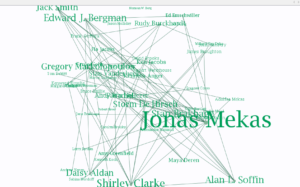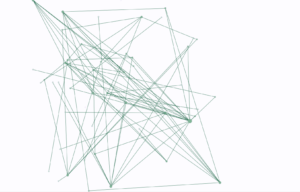For my second praxis assignment, I decided to visualize the friendship and intimacy of early American avant-garde filmmakers based on their collaboration & cast information in Film-makers Lecture Bureau Catalogue No. 1 (1969) (see fig 1) and supplementary research (when necessary). Continuing my interest in mapping demolished old Times Square’s adult theater (and relevant) venues before its disappearance, I wanted to digitize and visualize the ephemeral records of subcultural art/event participants (in this case, early American avant-garde filmmakers and actors) whose relationships (personal and/or creative friendships) are addressed fragmentary ways and not yet explored in terms of the shape and intensity of its networks. I research and write about American avant-garde films from their beginning to the present, and I (and other researchers/scholars/critics) emphasize collaborative & amateur community in illustrating the characteristics of early Avant-garde filmmaking, but I wasn’t sure how much (and how complicatedly) filmmakers/artists were actually connected, so I wanted to take advantage of this assignment for my studies of their friendships based on collaboration records in the catalogue. Film-makers Lecture bureau happened as a division of The Film-makers’ Cooperative (aka The New American Cinema Group) that was founded in 1961 and served as an artist-run, non-profit collective organization that hosted screenings & lectures as well as distributions of their film prints. It was located in 175 Lexington Avenue New York 10016 at that time (1969, the year of this catalogue printed), but, at some point (I still couldn’t figure when it was yet), it moved to their current address, 475 Park Avenue New York NY 10016.

fig 1
This catalogue has gathered individual artists’ — whose list is alphabetized by their last names — screenings & lectures along with the brief descriptions of their works and talks in the year of 1969. (But there’s no precise information of lecture/screening dates.) At times, the descriptions of the film have the collaboration & cast information, but it’s neither consistent nor patterned in any way. So it was challenging to collect the information of their friendships (either artistic or personal) but I’m interested in dealing with imperfect & ephemeral historical records like this even if that task often requires more work, so it was an enjoyable experience over all. The following images (fig 2, 3, & 4) are the screenshots of the “friendship” graphics that I made by using Gephi 0.9.2. Of course, to import spreadsheets of nodes and edges, I first collected data manually (even by using other catalogues, newspapers, scholarly writings, and online archives to some degree when the cast information is missing). Apparently, as I excavated more, there was too much information about collaborating and even personal relationships (family, romance, and so on) so I couldn’t go further than 12 pages of this initial catalogue. (The entire book is 72 pages long.) So the result I show below is less than 20 percent of their networks that should be digitized and certainly much less than the actual relationships that are not recorded in any way.
I used Libreoffice calc to make spreadsheets (as it was recommended by one of our TAs and DH fellows Patrick Smyth) and imported them in Gephi 0.9.2. There are 51 nodes (51 names of artists) and 82 edges (connections) so far. Most of them preferred collaboration or collective filmmaking (within this community) to individual filmmaking. But a few artists worked rather individually for minimalistic structural works (that do not need much filming and performers and instead rely on solitary editing process). A few actors were just spouses of artists and they didn’t connect to other artists. However, most of the filmmakers were connected crossing genders and those relationships created the various shapes of quartz-like terminations as much as they were connected around the important members of The New American Cinema Group, such as Jonas Mekas, Shirley Clarke, Gregory Markopoulos, Stan Brakhage, Storm De Hirsch, and others. Jonas Mekas is a Lithuanian American (refugee and then immigrant) filmmaker, and, as you can see from the screenshots, he was mutually connected to most of the avant-garde filmmakers at that time as much as he also worked as a full film critic (he was a first full-time film critic for The Village Voice). However, it doesn’t mean that he functioned/functions as a patriarchal figure in those connections although his name appears too large (as I wasn’t completely able to figure out how to size node labels gradually upon their popularity ranks although I tried so many times by adjusting the node ranking “degree”) In fact, as you can see other artists (women filmmakers included, such as Shirley Clarke, Storm De Hirsch, Daisy Aldan, and Marie Menken; I haven’t included her here just yet, among many others), without Mekas’ mediations, independently collaborated although it didn’t mean the exclusion of Jonas Mekas either in other projects. So in these images, their connections create multiple diamonds around some of the important figures in their community, and I suspect that it will create more if I add more nodes and edges as I further develop the project.

fig 2

fig 3

fig 4
Beyond this post as an assignment for this Intro DH class, I’d certainly like to further pursue this as I believe revealing collaborative and intimate (yet independent and democratic) nature of alternative (avant-garde or experimental, and amateur) filmmaking is important to distinguish those communal yet unrestrictive art practices from large studio centered commercial filmmaking. The former was (and is even now in a much less visible way) weaving an artist community and shaped the participants’ work and life at varying, intimate levels.


This is an interesting project, Hyemin! I liked that you dug into the personal relationships of the filmmakers, even though you found that could become a rabbit hole. I’ve been thinking about how Mekas became so connected because he was also a film critic. Does that mean some of these network connections might be with his opponents rather than his allies (since he might write several critiques of his opponents)? Although, opponents can sometimes have a greater impact on an artist’s work than his friends, so maybe being an ally or an opponent doesn’t actually matter that much in terms of a network.
Hi Dax:
Thanks for the insightful reading of my project! Mekas was a generous critic I think although he didn’t support everything, of course, but American Avant garde or experimental filmmakers were/are already marginal in art circles & overall society so I think within that community he was attentively engaging & knowledgeable. He wasn’t measurelessly kind but even when he didn’t praise someone’s work I don’t think they took it like a signal of a hostile relationship with Mekas, as the nature of their work wasn’t/isn’t for big money but for dialogue about art, poetry, (alternative) community, & life. Mekas didn’t think he was a critic in this sense as he didn’t actually “criticize.” But I should read his essays again! I’m sure there were some irremediable conflicts too. Very interesting to explore. Thanks again for your thoughts!